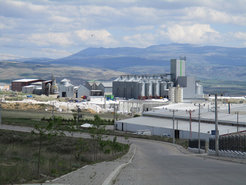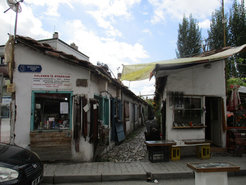Capitalist Motivations and Artisanal Adaptations in Çorum, Turkey
Author: Ceren Deniz
April 27, 2016
Before I came to Çorum for fieldwork, as any researcher would do, I looked up statistics, read about its history and got myself familiarized with major events and developments in its recent history and economy. This initial information gave the following picture: Çorum is a middle-sized city with a 525 thousand total, 280 thousand urban population. It had been listed by the government within the developmental priority regions of Turkey since 1988. Çorum is seen as a gate to central Anatolia from the Black Sea region. The archeological remains of the capital of the Hittite Empire, Hattuşaş, are within the borders of this province. However, the city has not become a tourist attraction in years, rather Çorum is famous for its roasted chickpeas (leblebi) in the national market. Recently economists and social scientists ranked the city as one of the emerging industrial centers in central Anatolia. Another distinguishing aspect of Çorum is its large Alevi[1] population besides the Sunni Muslim majority. 36 years ago, just before the 1980 military coup numerous nationalist Sunnis were mobilized to attack left-wing Alevis in Çorum and nearly after two months of street clashes, some 57 people, mostly Alevis, were killed.
Into the 7th month of fieldwork, my knowledge of Çorum has of course expanded, opening up many interesting aspects for research. Here however, I want to focus on some of the initial themes which were brought up to my attention by many Çorum residents early on in my research. These were great hints to proceed on. The main public concerns here in Çorum are that a) the city “still” does not have an airport of its own (although Merzifon Airport is 50 minutes car ride from the Çorum center), b) it lacks railroad connections to port and metropolitan cities and c) it still does not have a shopping mall. The lack of these three urban facilities occupy the local newspaper headlines at least once a month and are the first topics raised when talking about Çorum economy. Their lack is only significant in comparison to the neighboring cities such as Yozgat which is equally mundane, does not thrive as an industrial center and yet has all of three. People tend to explain the discrepancy politically: although both Yozgat and Çorum voted nearly 60% for the ruling Justice and Development Party (AKP), several Yozgat deputies were appointed as ministers but none from Çorum. Politicians’ lack of skills in acquiring higher positions within the party and hence being unable to bring investors to Çorum are mentioned as reasons for the difference. Furthermore the deputies are accused for not attending to the needs of the city, the reason given often as having been born but not raised in Çorum. Apart from the crucial difference of “being or not being from Çorum”, “being neglected” is another marker for the state of mind of people in Çorum.
There are further public narratives that reflect the same state of mind: one narrative bemoans that the founder of the Republic Mustafa Kemal Atatürk has never visited Çorum. The other is that although in early Republican era state-led industrialization was the main economic model, only two state-run factories were built in Çorum.[2] Çorum ranks quite low in its development indicators, upper class urban people go to Ankara or Samsun for shopping and educated people generally emigrate. Emigration is also related to the 1980 incidents mentioned above: accordingly the incidents made business people hesitant to invest in Çorum, so the city fell behind 20 years. While the state of being neglected makes “being from Çorum”, “doing something for Çorum” very valued, it also translates into some kind of local patriotism for Çorum. In one of the very recent issues of the journal “Business World” published by the Çorum Chamber of Commerce and Industry, the newly appointed Governor of Çorum outlines his despair about the city with the following words: “There is no air connection, no sea route, no railway ... There is nothing positive, you are not in proximity to raw materials, to marketing routes ... [This all] doesn’t make sense.”
Today, at the city center of Çorum, with its clock tower and the three main roads to north, south and northwest, one of the first visible things (also pointed out by many locals) is the large number of banks lined up on these roads. This seems to suggest that Çorum business people are quite rich and that many put their money in banks which operate with interest rates hinting that Islamic rule of avoiding interest rates might not apply. Nevertheless, one can also see that the side roads are miserable, houses are very old, most valuable space is used as parking lots. Then one wonders where all that money goes to and what this means to the local Çorum patriots? Furthermore, if state investments, raw materials and marketing routes were scarce, then how did people start businesses, make good trade deals and even begin exporting from Çorum in the last decades?

Obviously it is not possible to answer all of this in a short blog. But one thing one should keep in mind is that the discourse on the absence and neglect do have some aspects of truth. In fact, it seems the ‘lack of things’ motivates people to acquire them, adds to their determination and ambition for capitalist ventures, not only for profit but for making a livelihood to begin with. Secondly those who started business first by transporting goods with horse carts, then with motor vehicles seem to have accumulated capital earlier than others. Third, as brought to my attention by the Chamber and also by informants, is that there was a ‘culture of multiple partnerships’: often more than 10 men combined their savings to invest in one business. This is how tile, seed and paper factories were brought to life, at least in the 1970s onward. Today, it is feared that this culture has ceased to exist.
One example for this ‘culture’ is the Paper Factory:[3] it was established in Çorum after contacting agents in Istanbul had found out about the machines of an abandoned Italian paper factory and organized the partners and their savings, with which the machines could be bought, renewed and start operating. The question then is how these partners and their men operated those machines and organized the work flow, since they had by then no experience whatsoever. One strategy was to bring the Italian managers and workers as well as retired workers of SEKA[4] factories from nearby cities to Çorum. One businessman described this experience as a school, where people from all ranks –including the workers who came to the factory from nearby villages- learned artisanship, the machines, techniques, engineering, management and book keeping. He added to the list of acquired skills: manners, time keeping, and discipline as well. However, when the factory required more investments in the following years, the partners and their sons saw the additional investments as a burden. Instead they wanted to withdraw their shares from the paper factory to reinvest and deploy the skills and techniques they acquired in different businesses. This is pretty much how the culture of multiple partnership began to fall apart.


The transfer of knowledge, skills, techniques and manners from abroad can be observed in other cases as well, such as the first flour factory of Çorum which has followed a similar pattern. In these cases and also in others, the crucial part was to repair the machines which were broken or old. Some of the businessmen of today are the artisans of metals and welding in 1990s who have replaced the broken parts by learning from each other, imitating and developing each other’s work, and even creating new pieces and models. Another and earlier pattern of transferring artisanal skills was learning from and working with the local Armenians, who lived in Çorum and nearby counties but gradually fled after 1915 due to the widespread impact of Armenian genocide in Anatolia. In fact, there are plenty of stories about Armenian artisans that businessmen recall, that their fathers or their masters have been an apprentice of. Not only the skills but also the lands of local Armenians were transferred to the Muslims after their deportation and flight. These long time denied and disguised issues are rarely mentioned by only a few local industrialists and elites here. Therefore the extent of the appropriation of lands from Armenians to Muslim Turks is blurry and its impact on the development of Çorum trade and industry in 20th century is unclear. Nevertheless, the findings strongly hint that the appropriated lands of the Armenians have become a resource of wealth and capital for at least some of the new Muslim tradesmen who were flourishing in the early years of the Republic and whose grandchildren have probably become the elites of Çorum today.
Çorum’s history is complicated not only because of the ethnic cleansing of Armenians a century ago and the 1980s ‘incidents’ related to the Alevis. Contrary to the common knowledge available in everyday conversations, Çorum’s population is not only composed of Sunni and Alevi Turks. While their numbers are unknown, Sunni Kurds who lived in Çorum’s villages for centuries, Circassians who fled from wars and ethnic cleansing in Russia after 1864 and Alevi Kurds who fled from the Dersim Massacre at the end of 1930’s constitute the minorities in Çorum. However the cutting axis of Çorum people’s identities is not ethnicity, but the religious denominations. I learned early on from a real estate agent in Çorum that after the 1980 ‘incidents’ the main road from the Clock Tower to the North called Gazi Street has become the red line separating the Alevi and Sunni residential areas; former on the right side of the street, latter on the left side. The Circassians also have built a residential area of their own but they identify themselves more with tradition than religion, so their residential and cultural boundaries has been more flexible than those of the Sunnis-Alevis. Nevertheless, the boundaries between Alevis and Sunnis have also stretched through time. The main street where Alevis are concentrated is full of cafes and restaurants where Sunnis freely go, they also rent/buy houses there, but it is rarely the other way around. One of the reasons people mention as causing the end of the ‘culture of multiple partnerships’ is the resentment these two groups have come to feel for each other especially after the ‘incidents’. Today, nevertheless, people from different religious denominations do become business partners or work in each other’s companies. One should not assume however, that the tension is totally relieved in 36 years, becoming partners or working for the other’s company is quite selective and involves tensions, arrangements, struggles as well as resolutions. I hope to approach these issues in a more detailed manner in my interviews with the business owners and workers as well as during my participant observation in a machine factory in the following months of my research.
Notes
[1] Sunni tradition is officially recognized and culturally and financially supported by the Turkish state, while Alevism, a syncretic minority denomination in Islam, venerating the Caliphate of Ali, Prophet Mohammed’s niece and son-in-law, is not.
[2] Çorum Cement factory went into operation in 1957 and got privatized in 1992. According to the respondents between the ages of 40-60, the factory also served as a recreational facility for city bureaucrats, civil servants, lawyers, engineers, in addition to the workers and personnel of the factory. Çorum Sugar Factory is active since 1991. One should note that, in fact, the neighboring cities also have received similar amount of state investments.
[3] Now sold to a British owned company.
[4] SEKA is the abbreviation for Turkish Cellulose and Paper Factories Company, which is the first state industrial establishment of the Republic. SEKA opened up many paper factories all around Anatolia, was privatized in 1998 and closed down in 2005.


